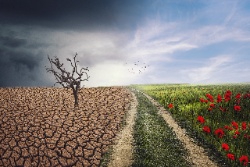Stock numbers continue downward trend
Stock numbers continue downward trend, says Meat & Wool New Zealand
Meat & Wool New Zealand’s Economic Service says drought and dairy expansion have continued to reduce sheep numbers, resulting in a 2.8 per cent drop in total sheep numbers, to 33.14 million for the year to 30 June 2009. This follows an 11.4 per cent decrease in sheep numbers the previous year.
Economic Service Executive Director Rob Davison says its annual stock number survey, which establishes the productive base of livestock for 2009-10, shows North Island sheep numbers decreased by 5.9 per cent (-1.0 million) while numbers remained almost static (+0.3 per cent) in the South Island.
“In the North Island, three consecutive years of drought in the East Coast regions has caused successive reductions in sheep numbers. In addition, drought in the summer and autumn of 2008, coupled with dairy herd expansion, resulted in significantly fewer lambs in 2008-09 (-12 per cent) than in the previous year. The flow-on effect was fewer lambs for export and fewer lambs to keep as replacements at 30 June 2009. Farmers’ need for cash flow and improved lamb prices compared with the last three years, particularly in the latter part of 2008-09, prompted more lambs to be drafted for export instead of being kept as replacements.”
Mr Davison says breeding ewe numbers dropped 3.4 per cent to 22.7 million, with North Island numbers down 2.9 per cent and South Island numbers down 3.8 per cent.
“The total number of hoggets or young sheep was almost static but there was a major difference between islands. North Island hogget numbers were down 12.2 per cent but South Island numbers were up 15.8 per cent. The South Island increase is measured against very low hogget retentions in the previous year. Some of this increase is likely to be lambs held over for slaughter in late winter.”
Mr Davison says early indications suggest this spring’s total lamb crop will be ahead of last year’s by around 0.50 million lambs (+2 per cent).
“This increase will mainly come from more lambs born per 100 ewes and will more than offset the 3.4 per cent decrease in breeding ewe numbers. However, the final arbiter for the actual lamb crop will be the weather this spring.
“Although this year’s lamb crop is likely to be ahead of last year’s, we expect the number of lambs to be available for export will be down 2 per cent. This is because farmers in regions previously affected by drought will need to retain more lambs than last year as replacements to rebuild sheep numbers.”
Meanwhile, beef cattle numbers decreased 1.7 per cent to 4.07 million, with a 1.9 per cent fall in the North Island and a 1.2 per cent decrease in the South Island.
Mr Davison says the South Island dairy herd increased an estimated 7.4 per cent while the North Island herd remained almost static. Last year, the total dairy herd grew by 6.0 per cent, but this year growth slowed to an estimated 2.8 per cent for the year to 30 June 2009.
ENDS


 University of Canterbury: What Makes People Tick Environmentally?
University of Canterbury: What Makes People Tick Environmentally? Gallagher Security: Release Of New Command Centre Unlocks New Era Of Security Tech
Gallagher Security: Release Of New Command Centre Unlocks New Era Of Security Tech Fix & Fogg: NASA Hand-picks Kiwi Nut Butter Brand To Travel To Space In NZ First
Fix & Fogg: NASA Hand-picks Kiwi Nut Butter Brand To Travel To Space In NZ First Citizens of the Sea: Sailors To Revolutionise Our Understanding Of Pacific Biodiversity
Citizens of the Sea: Sailors To Revolutionise Our Understanding Of Pacific Biodiversity Netsafe: Making A Splash With Online Safety: Netsafe Launches New Flagship Programme For Kids
Netsafe: Making A Splash With Online Safety: Netsafe Launches New Flagship Programme For Kids NZGBC: Flood Resilience PhD Student Widi Auliagisni Named Future Thinker Of The Year 2024
NZGBC: Flood Resilience PhD Student Widi Auliagisni Named Future Thinker Of The Year 2024



